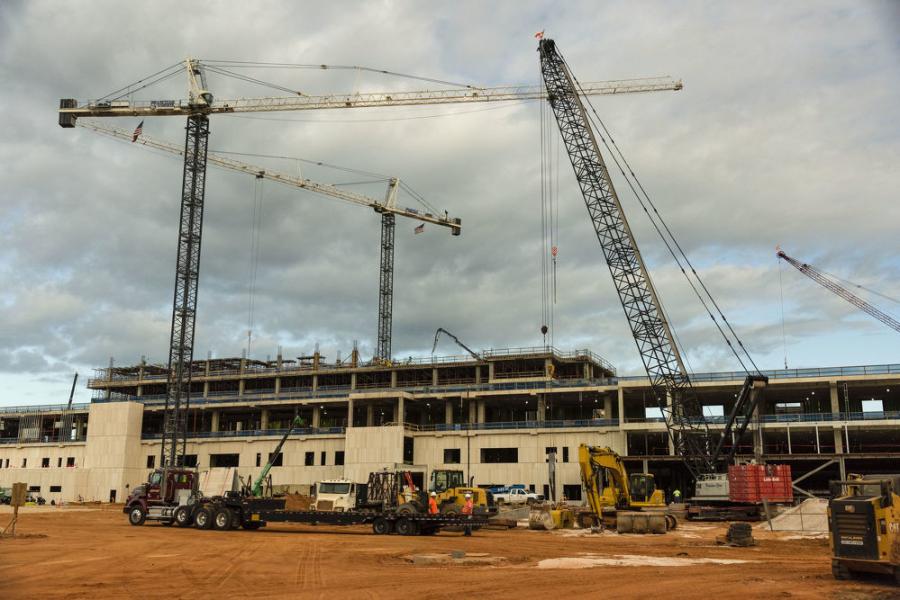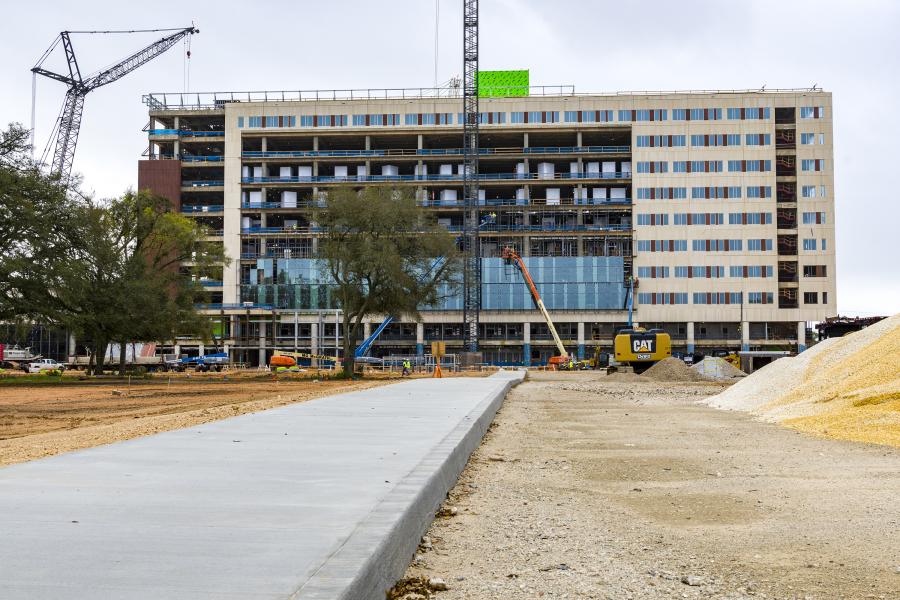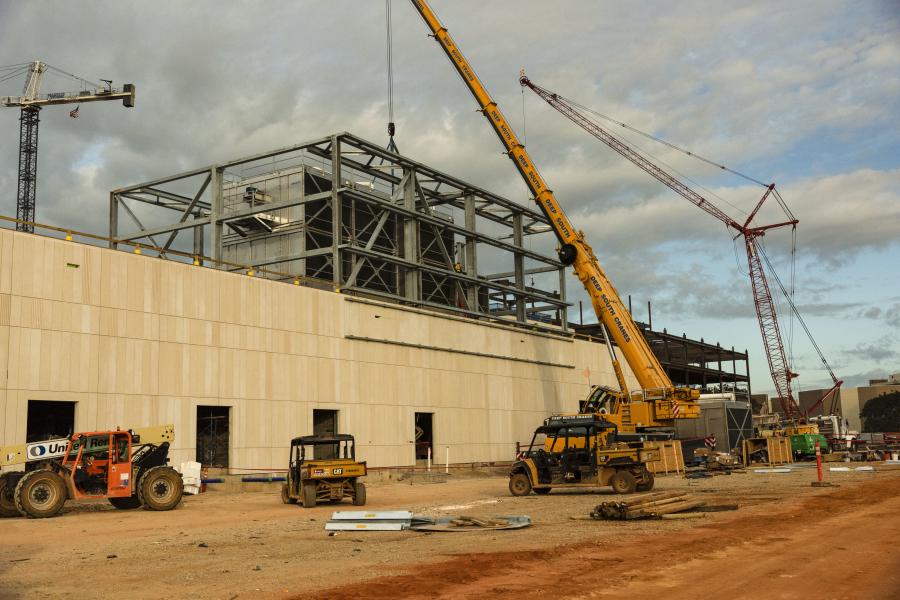Construction crews in Pensacola are working to complete a $636 million project that represents the single largest investment in health care facilities, services and programs in northwest Florida’s history.
(Baptist Health Care photo)
Construction crews in Pensacola are working to complete a $636 million project that represents the single largest investment in health care facilities, services and programs in northwest Florida's history. The new Baptist Health Care campus includes a 10-story, 602,000-sq.-ft. acute care hospital; a 6-story, 178,000-sq.-ft. Bear Family Foundation Health Center; a freestanding behavioral health unit; and a second, 80,000-sq.-ft. medical office building.
"Our goal is to make it seamless for those we serve to get what they need," said Mark Faulkner, president and CEO, Baptist Health Care. "We are committed to providing the very best care for our patients and team members, and our new facility will allow us to do exactly that. Better access, new and improved capabilities and updated technology are just the start."
In fall 2020, a ceremony celebrating the project's official launch took place exactly 71 years after the groundbreaking of the current hospital, although site preparation began prior to the event.
"On October 30, 1949, our founders broke ground to build Baptist Hospital with the purpose of bringing more modern health care to our community. This new campus is their legacy. It will allow us to forge ahead with renewed commitment and passion to care for the community for many years into the future, with the goal of improving the quality of life for all people, regardless of age and the stage of life they face."
Faulkner said the location of the new facility is ideal for those seeking treatment.
"The proximity to I-110 provides easier, faster and more direct access to care for people from all across northwest Florida and south Alabama than our current location, which is surrounded by residential property. Yet we are still less than three miles from our original location, and the community that means so much to us."
In February 2022, Baptist Health Care leaders and special guests joined Brasfield & Gorrie officials and nearly 1,000 construction crew members on site for a topping out ceremony that marked completion of the framework of the building.
"The program recognized the significance of the day and celebrated the skill, hard work and contributions made by the construction team. Following the program, guests watched as the last steel beam was lifted by crane to the top of the new acute care hospital and set into place. The beam was signed by team members, volunteers, visitors, construction workers and others."
One of the highlights of the project, according to Faulkner, will be the town square and healing gardens.
"The distinguishing feature of the new campus will be the many existing heritage oaks and magnolia trees, some of which are hundreds of years old. In recognition of this wonderful asset, these beautiful trees are at the heart of the development, in a central active town square where patients, visitors and our team members can enjoy the healing qualities of nature, stroll along a walking path incorporated among the trees, rest or participate in an outdoor wellness class. We understand how important quiet spaces to reflect and rejuvenate can be to healing. Several areas have been reserved and designed specifically for this purpose."
For Lee Thompson, project director of Birmingham-based contractor Brasfield & Gorrie, labor and supply chain issues have been the biggest challenges to date, but those issues appear to have been resolved.
"We have more than 800 workers on site now and expect to peak at 1,000 this summer," Thompson said. "We've faced some material availability challenges, but we've been able to overcome them thus far by working with our trade contractors, clients and design teams to develop innovative solutions."
The site included 36 parcels, with numerous structures that needed to be demolished before new work could begin. Although Baptist Health Care contracted demolition outside of the contractor's scope, Brasfield & Gorrie spent the better part of six months helping manage the logistics of removal and other enabling projects to prepare the building pad for construction.
Thompson said the site development plans capitalized on the property's approximately 57 acres and include around 1,200 surface parking spaces. The underground storm, sewer, power and water designs were complex, and required close coordination during construction.
Aside from typical excavation work for underground utilities, the site required many "deep excavation" activities.
"The installation of the underground retention system, the various stormwater chambers, the sewer system and the on-site sewer lift station all required excavations of +/- 30-inch deep to accommodate the final structures," Thompson noted. "Shoring and trenching were a must to perform these activities safely."
The property contains an underground stormwater retention system, which can hold up to one million gallons of water at peak capacity.
"In addition to the underground storage, there are seven stormwater ponds across the site to help manage the storms Pensacola often faces between May and November each year," said Thompson.
As with any construction project, crews have kept an eye on the forecast, but, so far, Mother Nature hasn't forced any delays.
"Weather can be a risk, but even Hurricane Sally hasn't slowed down construction on this project. We remain on schedule for completion in fall 2023."
Key tasks remaining include completion of exterior skin components, including exterior glass, metal panels and some roofing. Workers also must finish the interior buildout and finishes of the first floor, including the emergency department, imaging rooms, kitchen/dining and administrative areas. Interior buildout and finishes of the second floor, including operating rooms, procedure rooms, sterile processing and lab remain, as well as interior buildout and finishes of the third floor and patient tower, including ICU rooms, pharmacy, labor and delivery suites and medical surgery patient rooms. Landscaping and hardscaping in the meditation garden must be addressed, along with the lightwells, which provide daylight to the interior hospital spaces.
A variety of heavy machinery is being used on the project, including John Deere 120C, John Deere 250G, Komatsu PC290, Sany SY75C, Cat 336F, Cat 305E, Cat 306 and Cat 303.5E excavators; Cat D6N, D3K2 and D3 dozers; John Deere 644K and Cat IT38G wheel loaders; Mustang Manitou 1650RT, Cat 259B and Cat 259D3 skid steers; Cat 730 hauling trucks; Cat 120M2 graders; Cat CS54B and 65ZV rollers; Broce Broom street sweepers; Toro MBTX 2500 concrete/mud buggies; Genie SX-135 XC, Genie S-85 XS, JLG Ultra Boom and SkyJack SJ66T man lifts; Terex SK415-20, SK575-32 and SK415 tower cranes; mobile and crawler cranes; and Cat TL1055D, Genie GTH-844, Genie GTH-1056 and JCB C510 lulls/forklifts.
Thompson said building a health care facility is a methodical process, because of the systems necessary to support the facility's critical functions.
"In addition to planning for these systems, this project includes a central energy plant to serve the hospital's ongoing needs. The plant houses the generators and other equipment that will keep the hospital running smoothly. Coordinating the envelope and MEP systems for sustainability in weather and energy is a team effort.
"We also take planning and implementing life safety and code compliance seriously, with review throughout a project's design, pricing, start-up and construction phases."
Coordinating medical equipment is another essential part of health care construction.
"The precise equipment a hospital uses requires corresponding precision in construction, including accurate utility services, appropriate structural support, comprehensive planning for equipment routing and rigging and dust-free environments."
Thompson added that working on a project that will serve so many for years to come is a tremendous honor.
"We're passionate about building strong communities, and it's easy to see how a hospital campus contributes to its surroundings. This project also is providing a significant number of jobs for Pensacola-area residents. This project's impact on the community gets us excited to come to work every day." CEG
Cindy Riley
Birmingham, Ala., native Cindy RIley originally planned on a career in law, but during her sophomore year in college realized journalism was her true calling. A magna cum laude graduate of Samford University, Riley first worked in radio and TV. Named Best News Anchor, Best News Reporter and Best Investigative Reporter by the Associated Press, she interviewed numerous personalities, ranging from Dr. Henry Kissinger and President Bush to Michael Jordan and Captain Kangaroo.
As a print journalist, Riley has covered a variety of topics, including construction, business, health and the arts. In addition to CEG, her work has appeared in special reports for USA Today and the L.A. Times. Other publications have included New South Magazine, Portico, Thicket, Alabama Heritage, B-Metro, Business First and Birmingham Business Journal.
Read more from Cindy Riley here.
Today's top stories


























